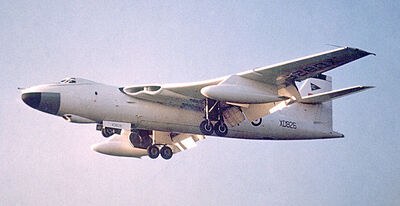The Vickers Valiant was the first of the Commonwealth’s V-bomber trio of strategic bombers that appeared in the

Early Valiants in Anti-flash white scheme
late 1950s and went on to carry the airborne element of the organization’s nuclear deterrent beyond the ’91 Disaster. While its tenure with the Royal Air Force as a bomber was short it would see extended service in the bomber, reconnaissance and survey roles for many years to come and was the most widely exported British bomber design since the Avro Lancaster.
Genesis[]
In January 1947, the British Air Ministry issued for an advanced jet bomber intended to carry nuclear weapons and fly near to the speed of sound at altitudes of 50,000 ft (15,000 m). Three firms: A.V. Roe, Handley-Page and Vickers submitted advanced designs intended to meet the stringent requirements. Of the three the Vickers design was seen as the most conservative and most risk-free. Development progressed smoothly with the prototype, now named Valiant, taking to the air in 1951 with the first production aircraft appearing in 1953.
Design[]
The Valiant was a conservative design, with a shoulder-mounted wing and four Avon RA.3 turbojets, each of 6,500 lbf (29 kN) thrust, two in each wing root. The design gave an overall impression of a plain and clean aircraft with simple aerodynamics. George Edwards described it appropriately as an "unfunny" aircraft. The root chord thickness ratio was 12% and allowed the Avon engines to be within the wing rather than on pods as in the contemporary Boeing B-47. This "buried engine" fit contributed to the aircraft's aerodynamic cleanliness. However, it made engine access for maintenance and repair difficult and increased the risk that the failure of one engine would contribute to the failure of its pair due to flying debris such as turbine blades. It also increased the complexity of the design of the main spar which had to be routed round the engines.

Valiant in flight
The Valiant wing had a "compound sweep" configuration, devised (and patented) by Vickers aerodynamicist Elfyn Richards. It had a 37° angle of sweepback in the inner third of the wing, reducing to an angle of about 21° at the tips. This was because the thickness/chord ratio could be reduced closer to the tips, balancing this against the sweep reduction in postponement of Mach effects such as buffeting and drag rise. Limiting in-service speed was Mach 0.84 and a typical cruise of Mach 0.75 at heights up to 55,000 ft when light. A "clean" Valiant (one without underwing tanks) could climb straight to 50,000 ft after take off unless it had heavy stores in the large bomb bay. The tail surfaces were swept back, and the horizontal tailplane was mounted well up the vertical fin to keep it clear of the engines' exhaust. The wing loading was low by modern standards and the Valiant was fitted with double-slotted flaps for takeoff (20° flap) and landing (40° or full flap, about 60°). The aircraft featured tricycle landing gear, with twin-wheel nosegear and tandem-wheel main gear retracting outward into the wing. Most of the aircraft's systems were electric including flaps and undercarriage.
Nuclear Bomber Into Service[]
Britain[]
The first squadron to be equipped with the Valiant was the RAF’s 138 Squadron, which formed at RAF Gaydon on 1 January 1955, with 232 Operational Conversion Unit forming at Gaydon on 21 February 1955 to convert crews onto the new bomber. From the outset the aircraft was tasked with providing the Commonwealth’s nuclear deterrent armed with free-fall nuclear weapons.

Valiant-Surveyor W.2
As newer more capable types entered service the RAF relegated their aircraft to other roles while a handful were extensively modified in to the Vickers Valiant-Surveyor PR.1. A few of these were later modified to Valiant-Surveyor W.2 weather reconnaissance aircraft. The W.2 remained in service past the '91 Disaster when it was used to monitor radioactive clouds across Europe.
Canada[]
The Royal Canadian Air Force was the second service to convert onto the Valiant replacing its Avro Lincolns in the strategic bomber role. The first aircraft arrived in Canada flown from Britain by Canadian crews in January 1956. The aircraft were painted in anti-flash white like their British counterparts but with toned down Canadian markings. Like the RAF however the Canadian usage of the Valiant was limited with Vulcans and Victors taking over the role in the early 1960s. The last aircraft was withdrawn in 1965.
Australia[]
The Royal Australian Air Force equipped with Australian-built Valiants in March 1956 initially equipping No.2 Squadron. Unlike their counterparts abroad they were designated B.20 to distinguish them from UK built examples and were delivered in a two tone blue paint scheme as at the time there was some uncertainty about whether they would form part of the Commonwealth nuclear deterrent. There were many Australian politicians lobbying against the basing of nuclear weapons on Australian soil. After a referendum in December 1956 the Australian people voted to have their country become a nuclear power and the Valiants became nuclear armed. Only a handful received the anti-flash white scheme however.
South Africa[]

RSAF Valiant B.51
The Royal South African Air Force received five ex-RAF examples from 1964 and these were subsequently brought up to B.51 standard. They served in the deep interdicter and reconnaissance roles and in 1969 were used in Operation: Southern Light to monitor communist insurgent camps in Namibia which helped put back the uprising by at least three years. The five aircraft served through the first half of the Namibian Bush War primarily performing reconnaissance missions but a few did get to drop bombs on communist targets before wear and tear forced their retirement.
